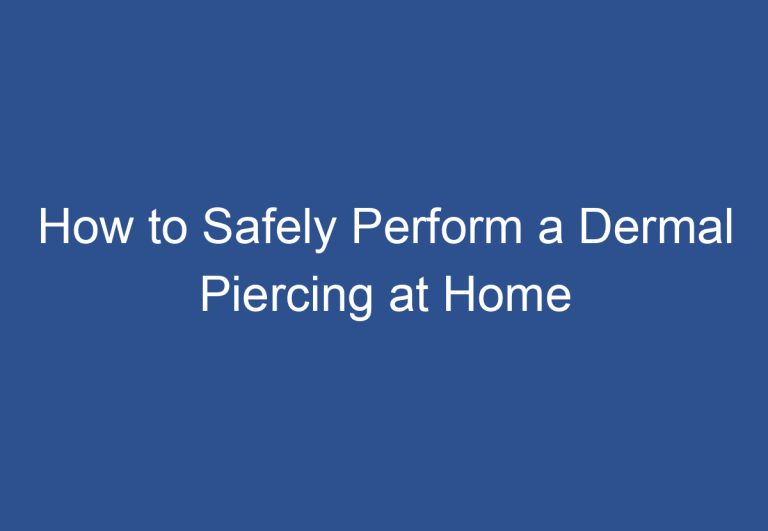How Bad Do Dermal Piercings Hurt: Everything You Need to Know
Dermal piercings are a unique form of body modification that have become increasingly popular in recent years. Unlike traditional piercings, dermal piercings are single-point piercings that involve the insertion of a small piece of jewelry under the skin. While dermal piercings can be a great way to express one’s individuality, many people wonder just how bad they hurt.

The answer to this question is not a simple one, as the level of pain associated with dermal piercings can vary greatly depending on a number of factors. Some people report feeling only a slight pinch during the piercing process, while others describe the pain as being more intense. Factors that can influence the level of pain include the location of the piercing, the size of the jewelry being used, and the individual’s pain tolerance.
Despite the potential for pain, many people find that the benefits of having a dermal piercing far outweigh any discomfort that may be experienced during the piercing process. Dermal piercings can be a great way to add a unique touch to one’s appearance, and they are also relatively easy to care for once they have been inserted. Ultimately, whether or not a person decides to get a dermal piercing will depend on their personal preferences and willingness to tolerate some level of discomfort.
Understanding Dermal Piercings

What Are Dermal Piercings?
Dermal piercings, also known as single-point piercings, are a type of body modification that involves placing jewelry under the skin’s surface. Unlike traditional piercings, which penetrate the skin and exit on the other side, dermal piercings use a dermal anchor or a small plate to hold the jewelry in place. This type of piercing can be done on almost any part of the body, including the face, chest, and back.
Procedure and Pain Experience
The procedure for a dermal piercing involves using a needle or a dermal punch to create a small hole in the skin. The jewelry is then inserted into the hole, and the dermal anchor is placed on top of the skin to hold it in place. Some piercers may use a scalpel to create the hole instead of a needle or dermal punch.
Dermal piercings can be painful, and the level of pain experienced can vary depending on the individual’s pain tolerance and the location of the piercing. Some people describe the pain as a sharp, intense sensation, while others experience a dull ache. The process may also involve some bleeding, but it is typically minimal.
Factors Influencing Pain
Several factors can influence the level of pain experienced during a dermal piercing. The location of the piercing is one of the most significant factors, as areas with more nerve endings or thicker skin may be more painful. The individual’s pain tolerance also plays a role, as some people are naturally more sensitive to pain than others.
It is essential to choose an experienced and reputable piercer to minimize the risk of complications and ensure a smooth healing process. Aftercare is also crucial, as proper cleaning and care can help prevent infections and other issues that can cause pain or discomfort.
Overall, dermal piercings can be a unique and stylish way to express oneself, but it is essential to consider the potential pain and risks before deciding to get one.
Aftercare and Healing

Proper Aftercare Practices
After getting a dermal piercing, it is important to follow proper aftercare practices to ensure the piercing heals properly and to minimize the risk of infection. The first step in aftercare is to keep the piercing clean. This can be done by cleaning the area around the piercing with a saline solution or an antibacterial soap. It is recommended to clean the piercing twice a day for the first few weeks after getting it done.
It is important to avoid touching the piercing with dirty hands and to avoid swimming or soaking in water for at least the first two weeks after getting the piercing done. Additionally, it is recommended to avoid changing the jewelry for at least six months after getting the piercing done, as this can increase the risk of infection and rejection.
Healing Process and Complications
The healing process for a dermal piercing can take anywhere from several weeks to several months. During this time, it is common to experience swelling, redness, and crusties around the piercing. It is important to avoid picking at the crusties or irritating the piercing in any way, as this can delay the healing process and increase the risk of infection.
Complications such as infection, rejection, scarring, and hypergranulation can occur with dermal piercings. Signs of infection include redness, swelling, pain, and a foul odor. If an infection is suspected, it is important to seek medical attention immediately. Rejection occurs when the body rejects the piercing and pushes it out of the skin. Scarring and hypergranulation can also occur with dermal piercings.
To prevent complications, it is important to follow proper aftercare practices and to monitor the piercing for any signs of infection or rejection. If any complications do occur, it is important to seek medical attention immediately.
In summary, proper aftercare practices are crucial for the healing process of a dermal piercing. It is important to keep the piercing clean and to avoid touching it with dirty hands. Complications such as infection, rejection, scarring, and hypergranulation can occur, and it is important to monitor the piercing for any signs of these complications. If any complications do occur, it is important to seek medical attention immediately.
Frequently Asked Questions

What level of pain can be expected from a dermal piercing?
The level of pain experienced during a dermal piercing can vary from person to person. However, in general, most people describe the pain as moderate to severe. The pain is typically described as a sharp, stinging sensation that lasts for a few seconds.
How does the pain from a dermal piercing change over time?
After the initial piercing, the pain usually subsides within a few minutes. However, the area around the piercing may remain tender and sore for a few days. As the piercing heals, the pain should gradually decrease.
What factors influence the pain experienced during dermal piercing?
Several factors can influence the pain experienced during a dermal piercing. These include the individual’s pain tolerance, the location of the piercing, and the skill of the piercer. It is essential to choose an experienced piercer who can perform the procedure quickly and efficiently.
Can dermal piercings lead to complications or risks?
Like any other piercing, dermal piercings can lead to complications or risks. These include infection, scarring, and rejection of the piercing. It is essential to follow proper aftercare instructions to minimize the risk of complications.
How long do dermal piercings typically last?
Dermal piercings can last anywhere from a few months to several years, depending on the individual’s skin type and aftercare. However, it is essential to note that dermal piercings are considered a semi-permanent form of body modification and may need to be removed at some point.
What are the different types of dermal piercing jewelry available?
There are several types of dermal piercing jewelry available, including flat dermal anchors, curved dermal anchors, and threaded dermal anchors. It is essential to choose the right type of jewelry for your piercing to ensure proper healing and minimize the risk of complications.






